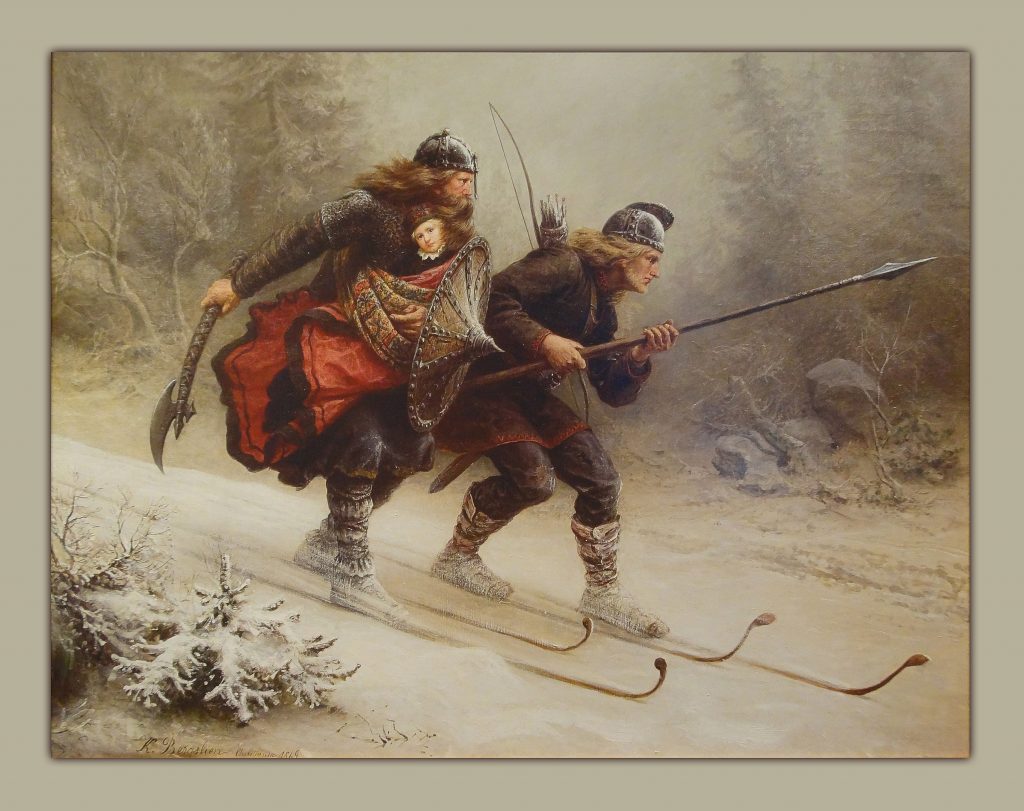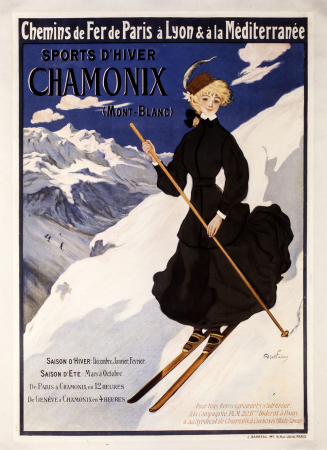It’s Tokyo Olympics! The Greatest Moments in the History of Summer Olympic Games
It’s Tokyo Olympics! It’s time when the greatest athletes gather in one place and compete against one other. If transported to the...
Marina Kochetkova 23 July 2021
Artists have long captured the magic of snow. During the 19th century, when winter sports like skiing, skating, and sledding became more popular in Europe, many artists began to depict these activities. Some of my favorite examples focus on skiing. This exciting sport makes for a perfect artistic subject, a pastime that can look as effortless as it is difficult and as beautiful as it is perilous. Tighten your boots, let’s take a look at skiing in art history!
Like many of the best competitive skiers, some of the strongest paintings of winter sports are by artists who come from mountainous areas. Born at the end of the 19th century, the artist and architect Alfons Walde (1891–1958) is one of the best-known chroniclers of Austrian Alpine life. Walde was born in Oberndorf, in the Tyrol mountains. He studied in Vienna, where he participated in the Vienna Secession alongside artists like Gustav Klimt and Josef Hoffmann. Walde was interested in depicting his home region and its traditions, an artistic ethos that aligned with the democratic, decentralizing focus of the Secession.

Skiing in Art: Alfons Walde, Schifahrer bei der Alm, 1935, private collection. Auktionshaus Hassfurther.

Skiing in Art: Alfons Walde, Zwei Schifahrerinnen, 1925, Museum Kitzbühel, Kitzbühel, Austria.
Cuno Amiet (1868–1961) was a Swiss modernist known for his experimentation with color. An iconoclast who rejected the norms of academic art, he developed a style that drew from the Expressionist and Impressionist traditions. He was an extremely prolific artist with a passion for landscapes, especially winter scenes. His Snowy Landscape (Deep Winter) is a large and energetic canvas. The work evokes the sublime of a snow-covered landscape that seems to engulf the small, solitary skier.

Skiing in Art: Cuno Amiet, Snowy Landscape (Deep Winter), 1904, Musée d’Orsay, Paris, France.
The German artist Paul Klee (1879–1940) harbored a life-long passion for Alpine subjects, often painting whimsical mountain landscapes. In a watercolor entitled Kleine Winterlandschaft mit dem Skiläufer (Small Winter Landscape with a Skier) Klee playfully depicts a skier moving through a wintery forest in his signature abstract style.

Skiing in Art: Paul Klee, Kleine Winterlandschaft mit dem Skiläufer, 1924, Albertina, Vienna, Austria.
One of Finland’s most well-known artists, Akseli Gallen-Kallela (1865–1931) studied in Helsinki and Paris. His style is simultaneously Romantic and Realist and often celebrates the almost supernatural beauty of the natural world. Gallen-Kallela was a passionate outdoorsman and demonstrates this familiarity in The Skiers Akseli and Jorma Gallen-Kallela. In a highly saturated, chromatic work he depicts two skiers, their faces red from the cold, racing through the snow at sunset. A stirring portrayal of both the beauty and pain of skiing.

Skiing in Art: Akseli Gallen-Kallela, The Skiers Akseli and Jorma Gallen-Kallela, 1909, private collection. MeisterDrucke.
Lill Tschudi (1911–2004) was a Swiss artist who specialized in linocut prints. Some of her favorite subjects included athletes, especially skiers. Her prints, typically in black and white, are spirited and vibrant. A modernist, she often abstracted the forms to present an exciting and graphic image.

Skiing in Art: Lill Tschudi, Ski Weekend, 1935. Estate Lill Tschudi Switzerland.
For Nordic countries, painting a winter scene was also a way to express national pride. The work of Axel Ender (1853–1920) exemplifies this phenomenon, known as Romantic nationalism. The Norwegian artist depicts a picturesque, rural life in his genre scenes that often contain figures of ice skating, sledding, or skiing. In Cross-Country Skiing, a well-dressed couple heads out for an excursion in the snow. The Realist style celebrates the individuality of the figures while still presenting them as symbols of Norwegian national identity.

Skiing in Art: Axel Hjalmar Ender, Cross-Country-Skiing, 19th century, Bonhams Collection, London, UK.
Another Norwegian painter who used skiing to represent national pride was Knud Bergslien (1827–1908). Bergslien studied in Norway and at several European academies before becoming a professor who shaped a generation of Norwegian artists including Edvard Munch. In his much-celebrated work, Skiing Birchlegs Crossing the Mountain with the Royal Child, Bergslien depicts a famous episode from Norwegian history. The work combines history painting with themes of Romantic nationalism to create a nostalgic and patriotic scene.

Skiing in Art: Knud Bergslien, Skiing Birchlegs Crossing the Mountain with the Royal Child, 1869, Holmenkollen Ski Museum, Oslo, Norway.
N.C. Wyeth (1882–1945) was an American painter and illustrator who gained national recognition for his illustrations for books. He belonged to Howard Pyle’s Brandywine school along with the likes of Norman Rockwell and Maxfield Parrish. Wyeth’s painting style was largely Realist, and he had a deep passion for landscapes. Yet his works often also contained dramatic elements, likely influenced by his career as an illustrator. He frequently depicted figures in movement, like his The Skier (The Ski Runner). This piece shows a man gliding down a hill in the shadow of a mountain.

Skiing in Art: N.C. Wyeth, The Skier (The Ski Runner), 1910. Mutual Art.
N.C.’s son also became a painter. Andrew Wyeth (1917–2009) even took up many of his father’s preferred subjects. In Chestnut Ridge, Wyeth paints a cross-country skier pausing to take in the view.

Skiing in Art: Andrew Wyeth, Chestnut Ridge, ca. 1944, Buffalo AKG Art Museum, Buffalo, NY, USA.
The French painter Gabriel Loppé (1825–1913) took skiing and painting to new heights. After growing up in the French countryside, Loppé discovered a passion for mountaineering. One day on an expedition, he came across artists sketching an Alpine landscape. Inspired, he taught himself to draw and paint in order to capture well-earned views after a hard climb or ski. The first foreigner to be accepted into the Alpine Club, Loppé became famous both for his adventurous accomplishments and his mountain landscapes. One of his favorite subjects was the Mont Blanc. In the painting L’Ombre du Mont Blanc au Coucher du Soleil du 6 Août 1873 Loppé shows the mountain at sunset, dwarfing three skiers.

Skiing in Art: Gabriel Loppé, L’Ombre du Mont Blanc au Coucher du Soleil du 6 Août 1873, 1873, private collection. Le Dauphine Libere.
For many native people, skiing is a way of life and a means of survival. In this ink drawing, Inuit artist George A. Ahgupach (1911–2001) presents a monochromatic scene of a man being pulled across an icy landscape by his huskies. The work is a joyful and dynamic glimpse into a unique way of life.

Skiing in Art: George A. Ahgupach, Man Skiing with Dogs, ca. 1930, parchment, ink, blood serum, carbon, The Metropolitan Museum of Art, New York, NY, USA.
Skiing is perhaps most ubiquitous in the graphic arts due to the popularity of travel posters. Prints of travel posters recall the nostalgia of the mid-century leisure boom that brought with it the rise of skiing and ski resorts.

Skiing in Art: Abel Faivre, Sports d’hiver Chamonix Chemins de fer de Paris à Lyon & à la Méditerranée, 1905, J. Barreau Printer, Musée des Arts Décoratifs, Paris, France.

Skiing in Art: Werner Bischof, The Sun of St. Moritz, Olympische Winterspiele, 1940, offset lithograph. Tomkinson Churcher.
Hopefully this list has inspired you to plan a ski trip, or head to your local museum in search of snowy subjects, (or maybe even both, if you’re now planning a visit to the Ski Museum in Oslo). Either way, see you on the slopes!
DailyArt Magazine needs your support. Every contribution, however big or small, is very valuable for our future. Thanks to it, we will be able to sustain and grow the Magazine. Thank you for your help!